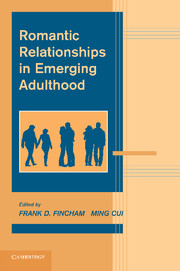Book contents
- Frontmatter
- Contents
- List of Contributors
- Foreword
- PART I INTRODUCTION
- PART II CONCEPTUAL AND METHODOLOGICAL FOUNDATIONS
- PART III THE DEVELOPMENTAL CONTEXT OF ROMANTIC RELATIONSHIPS IN EMERGING ADULTHOOD
- PART IV RELATIONSHIP PROCESSES IN EMERGING ADULTHOOD
- 9 The Evolution of Romantic Relationships: Adaptive Challenges and Relationship Cognition in Emerging Adulthood
- 10 Initiating and Evaluating Close Relationships: A Task Central to Emerging Adults
- 11 Putting the Romance Back Into Sex: Sexuality in Romantic Relationships
- 12 Understanding Romantic Relationships Among Emerging Adults: The Significant Roles of Cohabitation and Ambiguity
- 13 Implications of Parasympathetic Nervous System Functioning for Affect Regulation and Romantic Relationships in Emerging Adulthood
- PART V PRACTICAL IMPLICATIONS
- Index
- References
10 - Initiating and Evaluating Close Relationships: A Task Central to Emerging Adults
Published online by Cambridge University Press: 06 December 2010
- Frontmatter
- Contents
- List of Contributors
- Foreword
- PART I INTRODUCTION
- PART II CONCEPTUAL AND METHODOLOGICAL FOUNDATIONS
- PART III THE DEVELOPMENTAL CONTEXT OF ROMANTIC RELATIONSHIPS IN EMERGING ADULTHOOD
- PART IV RELATIONSHIP PROCESSES IN EMERGING ADULTHOOD
- 9 The Evolution of Romantic Relationships: Adaptive Challenges and Relationship Cognition in Emerging Adulthood
- 10 Initiating and Evaluating Close Relationships: A Task Central to Emerging Adults
- 11 Putting the Romance Back Into Sex: Sexuality in Romantic Relationships
- 12 Understanding Romantic Relationships Among Emerging Adults: The Significant Roles of Cohabitation and Ambiguity
- 13 Implications of Parasympathetic Nervous System Functioning for Affect Regulation and Romantic Relationships in Emerging Adulthood
- PART V PRACTICAL IMPLICATIONS
- Index
- References
Summary
Emerging adulthood (EA) has been defined as a time between the ages of 18 and 25, during which individuals are neither adolescents who have never left home, live with their parents (or parent), and are highly dependent on their parents (or parent) nor adults who have assumed full responsibility for themselves and for others, such as a romantic partner or a child. Many of these individuals are going to college, technical school, or graduate school. Others are trying out careers. Sometimes they are living with a partner, sometimes with parents, and sometimes alone. This time has been declared a special stage of life, at least in western culture (Arnett, 2000) – a stage described as a time of exploration and uncertainty and also of self-focus and self-concern. Emerging adults are exploring options, evaluating possible romantic relationships and world views, and preparing for and trying out careers they may eventually assume. It is a time of many choices and few commitments.
For the moment this stage of life has been defined by age, tasks, and a lack of commitments. Little has been said about the intra- and interpersonal psychological processes involved in the tasks of this period. We believe an understanding the psychological processes common during this stage of life is important to understanding why it seems to be a distinct life stage. It is important to ask, what gives this stage of life its own distinct “feel?”
- Type
- Chapter
- Information
- Romantic Relationships in Emerging Adulthood , pp. 190 - 212Publisher: Cambridge University PressPrint publication year: 2010
References
- 9
- Cited by



